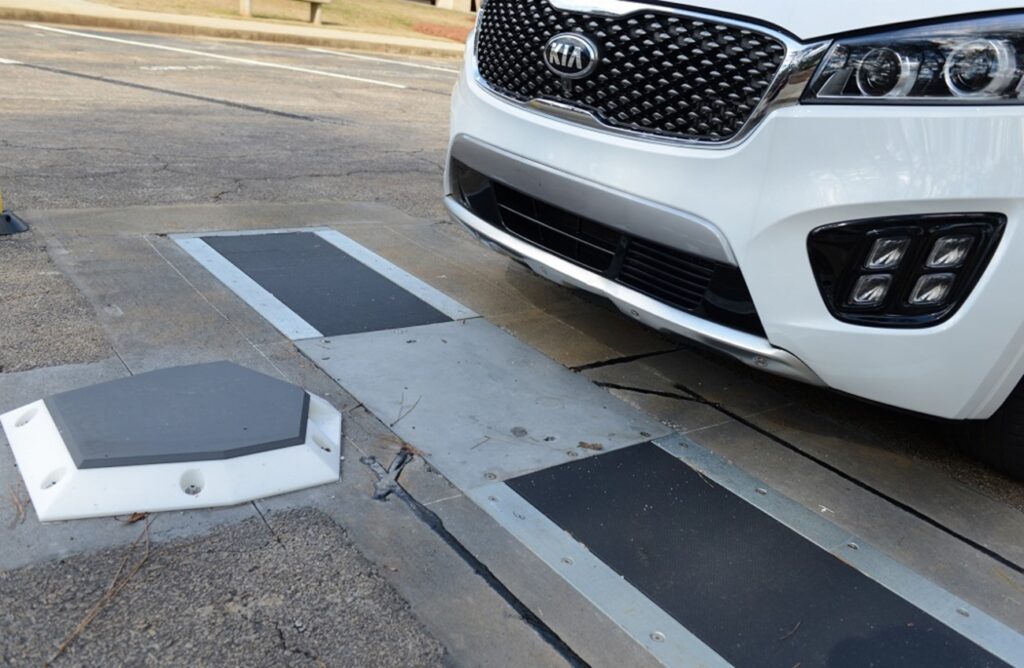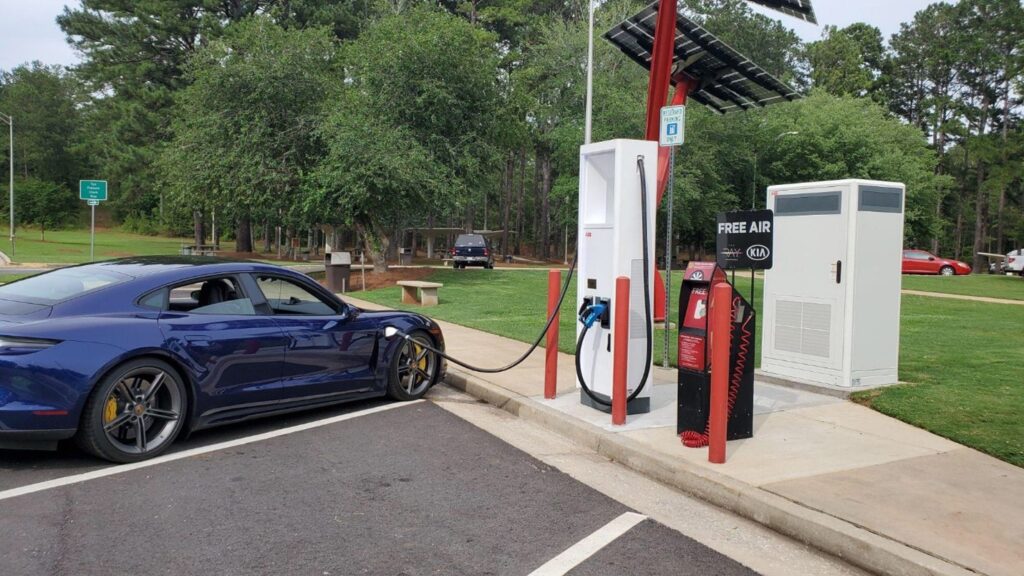The Ray is an independent nonprofit entity operating on the Ray C. Anderson Memorial Highway, which spans an 18-mile stretch of interstate between LaGrange and West Point on Interstate 85 in Troup County, Georgia. The name is well-chosen, honoring Anderson as a champion of industrial sustainability and alluding to the energy-charged solar rays which offer sustainable energy and support The Ray’s mission: zero carbon, zero waste, and zero deaths. This mission connects and sustains communities in a way that moves toward net-zero goals, supports wildlife and safety, and saves or even generates resources.[i] The Ray partners with the Georgia Department of Transportation (GDOT) and other public, private, and academic entities to test smart and sustainable transportation technologies. There are eleven technologies currently being tested by The Ray, with more waiting in the wings.[ii]
There are substantial benefits to approaching highways as a focus area in improving safety and sustainability. NHTSA estimates point to 31,785 deaths in traffic crashes during the first nine months of 2022, with ITS offering safety improvements and more efficient incident response.[iii] The IEA estimated that transportation accounted for 37% of end-use sector CO2 emissions in 2021, highlighting the significance of the sector’s transition toward decarbonization. The Ray’s data points to 52,000 acres suitable for solar development at interstate exits in the contiguous United States, capable of generating 36 terawatt hours of energy a year and powering 12 million passenger EVs.[iv] Rather than specifying exclusively in traffic safety systems, vehicle electrification, or any single technology, The Ray has embraced the concept of a regenerative mobility ecosystem. Their work supports a diversification of smart and sustainable technologies that will build the confidence of public and private entities who are weighing the urgency with which to transition to new systems amidst the confines of their operational realities.[v]
Project Purpose
To avoid tech exclusivity, The Ray Highway hosts a broad range of roadside technologies. These include a system that allows for tire pressure and tread depth readings as well as tire sidewall readings, allowing drivers to obtain information about tread depth and pressure specific to their vehicle, identify how much usable life is left on the tire, and where to find a suitable replacement; solar-powered EV charging that provides drivers a free 175kW charge for their electric vehicles; roadside vegetation and wildflowers to beautify, improve agricultural wellbeing, and fortify soil against stormwater; a rubber-added asphalt mix that reduces road noise and increases durability; and others.[vi] The tire safety check sensors are visible below.

The Ray’s tire safety check station alerts passing drivers of information on any of their tires via printed slip. Source: The Ray, 2022
Outcomes
Beyond the technical improvements enabled by testing in areas with industrial and civilian traffic, The Ray’s emphasis on diverse technology ecosystems has shown that those ecosystems help fuel the future development and implementation of new technologies. A representative of The Ray spoke on the need to assure both the private sector and state or local government agencies of the certainty of operations in a very low infrastructure reality.[vii] The resources invested into one sector of intelligent transportation—be it EVs, CVs and AVs, or real-time logistic and diagnostic data—strengthen the shared ecosystem and create a gravity that draws in funding, scientific interest, and confidence in embracing a new way of doing things. For rural communities, the earliest developments in these ecosystems may be charging infrastructure to meet demand from freight EVs, with roadside data gathering and other ITS systems to follow.[viii] Charging infrastructure can be seen below.

The Ray’s free solar-powered EV charging station. Source: The Ray, 2022
Resources
For an ecosystem of ITS and EV, CV, and AV support systems, communities must invest in a broad array of technologies with their own costs and requirements for upkeep. The Ray has seen a rural success story in Troup County paving its first rubber road even prior to their own experiments and cites collaborations between local governments and private entities as bringing and maintaining digital and physical infrastructure in impoverished or low-population communities. The model which has enabled much of this success, particularly for states and locales which lack the money to commit large infrastructure investments is the public-private partnership.[ix] The Ray is a public-private partnership (P3), and even considers itself a P4 through adding a philanthropic dimension to the partnership.[x] With the help of these connections, carefully negotiated and comprehensive contracts bring private sector investment potential—domestic and international—to public infrastructure needs, the private party or parties paid, possibly in part or in full, with value generated by the developed infrastructure. By including philanthropy, The Ray adds tremendous value to partnerships by leveraging specialized knowledge, skill sets, and connections unique to nonprofits.
The Ray’s spokesperson described P3s and P4s as a great opportunity for states and communities, calling the agreements a land use solution. Here a government with limited funds but with potential projects expected to generate value can contract a P3 or P4 and navigate issues such as including land fees or power purchase deals, requiring pollinator friendly spaces, private handling of upkeep for the duration, and more. Georgia’s legislature and governor have taken steps to update P3 laws, providing in appropriate cases one potential solution to the unique infrastructure needs and funding challenges faced by rural areas.[xi] Determining when a partnership contract is the optimal solution, selecting the partner offering the best value for money, and negotiating a successful contract will require localized governments to study past successes and failures. As infrastructure needs are met, the stage will be set for what The Ray considers the coming challenge in transportation: updating funding system as new technologies make existing systems for funding transportation infrastructure obsolete.[xii]
For more information about The Ray, visit the organization’s website at https://theray.org.
[i] The Ray C. Anderson Foundation, The Ray. https://www.raycandersonfoundation.org/the-ray
[ii] The Ray. https://theray.org
[iii] “NHTSA Estimates for First Nine Months of 2022 Suggest Roadway Fatalities Beginning to Level Off After Two Years of Dramatic Increases.” National Highway Traffic Safety Administration. https://www.nhtsa.gov/press-releases/nhtsa-estimates-traffic-deaths-2022-third-quarter
[iv] The Ray. https://theray.org
[v] Personal communication with Allie Kelly, January 2023
[vi] The Ray. https://theray.org
[vii] Personal communication with Allie Kelly, January 2023
[viii] Personal communication with Allie Kelly, January 2023
[ix] Personal communication with Allie Kelly, January 2023
[x] Personal communication with Sarah Beth Grizzle, April 2023
[xi] Personal communication with Allie Kelly, January 2023
[xii] Personal communication with Allie Kelly, January 2023
This report was delivered to the U.S. Department of Transportation in 2023. It was primarily authored by NADO Associate Director Carrie Kissel and NADO Research Fellow Danny Tomares. Many transportation agency staff and others assisted with this project in a variety of ways. We offer deep and heartfelt thanks to all the individuals who have provided information and images, consented to be interviewed, and offered editorial guidance in support of this research. Any opinions, findings and conclusions, or recommendations expressed in this publication are those of the authors and do not necessarily reflect the views of U.S. DOT or the NADO Research Foundation.
To read more about the NADO Research Foundation’s ITS case studies, follow this link.


